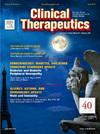Real-world Use of Mogamulizumab Among Patients With Mycosis Fungoides and Sézary Syndrome Before and During COVID-19 in the United States
IF 3.2
4区 医学
Q2 PHARMACOLOGY & PHARMACY
引用次数: 0
Abstract
Purpose
During the coronavirus disease 2019 (COVID-19) pandemic, professional organizations suggested extending dosing intervals for systemic cancer therapies to limit in-person visits. Mogamulizumab, indicated for adults with relapsed or refractory mycosis fungoides (MF) or Sézary syndrome (SS) after ≥1 prior systemic therapy, should be administered every 7 days of the first 28-day cycle (loading) and every 14 days of each subsequent cycle (maintenance) according to the approved prescribing information in the United States (US). This study examined the real-world use of mogamulizumab before and during the COVID-19 pandemic in the US.
Methods
Using Symphony Health's Integrated Dataverse (IDV) database, adults with ≥1 diagnosis of MF or SS and ≥1 mogamulizumab claim between October 1, 2018 and December 22-, 2022 were identified. Patients in MF and SS cohorts were divided into 3 subgroups based on the date they initiated mogamulizumab treatment: pre-COVID-19 (October 1, 2018–March 31, 2020), COVID-19 Phase 1 (April 1, 2020–July 31, 2021), and COVID- 19 Phase 2 (August 1, 2021–December 22, 2022).
Findings
During the study, 270 patients with MF and 337 patients with SS initiated mogamulizumab. The pre-COVID-19, COVID-19 Phase 1, and COVID-19 Phase 2 subgroups included 95, 81, and 94 patients with MF and 124, 119, and 94 patients with SS, respectively. In the MF cohort, mean loading dosing intervals were 13, 12, and 9 days for the pre-COVID-19, COVID-19 Phase 1, and COVID-19 Phase 2 subgroups, respectively, and mean maintenance dosing intervals were 16, 16, and 16 days, respectively. In the SS cohort, mean loading dosing intervals were 16, 11, and 11 days, and mean maintenance dosing intervals were 19, 18, and 16 days, respectively. For both cohorts, more patients in the COVID-19 Phase 1 and Phase 2 subgroups than in the pre-COVID-19 subgroup had gaps of ≤10 days between loading doses and ≤21 days between maintenance doses.
Implications
In patients with MF and SS, loading dosing intervals in the pre-COVID-19 period were longer than the loading schedule per the approved prescribing information, but there was a trend towards closer concordance in the COVID-19 periods. Maintenance dosing intervals in patients with MF were consistently similar to the approved schedule across treatment periods, and in patients with SS became more closely aligned over time. Thus, dosing intervals for mogamulizumab in both loading and maintenance cycles do not appear to have been extended during the COVID-19 Phase 1 and Phase 2 periods compared with the pre-COVID-19 period, despite recommendations to extend dosing intervals for systemic cancer therapies during COVID-19.
在美国 COVID-19 之前和期间,真菌病和塞扎里综合征患者实际使用莫干单抗的情况。
目的:在2019年冠状病毒病(COVID-19)大流行期间,专业组织建议延长系统性癌症疗法的给药间隔时间,以限制亲自就诊。莫加单抗适用于既往接受过≥1次系统治疗后复发或难治性真菌病(MF)或塞扎里综合征(SS)的成人患者,根据美国批准的处方信息,莫加单抗应在第一个28天周期内每7天给药(负荷)一次,并在随后的每个周期内每14天给药(维持)一次。本研究调查了美国 COVID-19 大流行之前和期间莫干珠单抗的实际使用情况:使用 Symphony Health 的 Integrated Dataverse (IDV) 数据库,对 2018 年 10 月 1 日至 2022 年 12 月 22 日期间≥1 次诊断为 MF 或 SS 且≥1 次使用莫干单抗的成人进行了鉴定。根据患者开始使用莫干单抗治疗的日期,将 MF 和 SS 组患者分为 3 个亚组:COVID-19 前(2018 年 10 月 1 日至 2020 年 3 月 31 日)、COVID-19 1 期(2020 年 4 月 1 日至 2021 年 7 月 31 日)和 COVID- 19 2 期(2021 年 8 月 1 日至 2022 年 12 月 22 日):研究期间,270 名 MF 患者和 337 名 SS 患者开始使用莫干单抗。COVID-19前期、COVID-19一期和COVID-19二期分组中分别有95、81和94名MF患者和124、119和94名SS患者。在MF队列中,COVID-19前、COVID-19一期和COVID-19二期分组的平均负荷给药间隔分别为13天、12天和9天,平均维持给药间隔分别为16天、16天和16天。在 SS 分组中,平均负荷给药间隔分别为 16 天、11 天和 11 天,平均维持给药间隔分别为 19 天、18 天和 16 天。在这两个队列中,COVID-19第一期和第二期亚组中,与COVID-19前亚组相比,更多患者的负荷剂量间隔≤10天,维持剂量间隔≤21天:在 MF 和 SS 患者中,COVID-19 前阶段的负荷剂量间隔比批准处方信息中的负荷剂量间隔长,但 COVID-19 阶段有更接近一致的趋势。中耳炎患者在各治疗期的维持用药间隔始终与批准的时间表相似,而 SS 患者的用药间隔随着时间的推移变得更加一致。因此,尽管有人建议在 COVID-19 期间延长全身性癌症疗法的给药间隔,但与 COVID-19 之前相比,COVID-19 第一和第二阶段期间莫干珠单抗的负荷和维持周期给药间隔似乎并未延长。
本文章由计算机程序翻译,如有差异,请以英文原文为准。
求助全文
约1分钟内获得全文
求助全文
来源期刊

Clinical therapeutics
医学-药学
CiteScore
6.00
自引率
3.10%
发文量
154
审稿时长
9 weeks
期刊介绍:
Clinical Therapeutics provides peer-reviewed, rapid publication of recent developments in drug and other therapies as well as in diagnostics, pharmacoeconomics, health policy, treatment outcomes, and innovations in drug and biologics research. In addition Clinical Therapeutics features updates on specific topics collated by expert Topic Editors. Clinical Therapeutics is read by a large international audience of scientists and clinicians in a variety of research, academic, and clinical practice settings. Articles are indexed by all major biomedical abstracting databases.
 求助内容:
求助内容: 应助结果提醒方式:
应助结果提醒方式:


